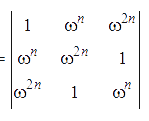Assertion (A): If 1,ω,ω2 are the cube roots of unity, then roots of equation (x−2)3−27=0 are 5,2+3ω, 2+3ω2, Reason (R): If α be one cube root of a number, then its other two cube roots are αωandαω2 (A) Both A and R are true and R is the correct explanation of A (B) Both A and R are true R is not the correct explanation of A (C) A is true but R is false. (D) A is false but R is true.
To solve the problem step by step, we need to analyze both the assertion (A) and the reason (R) provided in the question.
Step 1: Understanding the Assertion (A)
The assertion states that if 1,ω,ω2 are the cube roots of unity, then the roots of the equation (x−2)3−27=0 are 5,2+3ω,2+3ω2.
Solution:
1. Start by rewriting the equation:
(x−2)3−27=0
This can be rearranged to:
(x−2)3=27
2. Taking the cube root of both sides, we find:
x−2=3(the real cube root)
This gives us:
x=3+2=5
3. The cube roots of 27 can also be expressed using the cube roots of unity. The other two cube roots can be found by multiplying the real cube root by the cube roots of unity:
3ωand3ω2
4. Therefore, we have:
x−2=3ω⇒x=2+3ω
x−2=3ω2⇒x=2+3ω2
5. Thus, the roots of the equation are:
5,2+3ω,2+3ω2
Step 2: Understanding the Reason (R)
The reason states that if α is one cube root of a number, then its other two cube roots are αω and αω2.
Solution:
1. Let’s denote the number whose cube roots we are considering as k.
2. If α is a cube root of k, then:
α3=k
3. The other cube roots can be expressed as:
αωandαω2
4. We can verify:
(αω)3=α3ω3=k⋅1=k
(αω2)3=α3(ω2)3=k⋅1=k
5. Hence, αω and αω2 are indeed also cube roots of k.
Conclusion
Both the assertion (A) and the reason (R) are true, and R is the correct explanation of A. Therefore, the correct answer is:
(A) Both A and R are true and R is the correct explanation of A.
1. Start by rewriting the equation:
(x−2)3−27=0
This can be rearranged to:
(x−2)3=27
x−2=3(the real cube root)
This gives us:
x=3+2=5
3ωand3ω2
x−2=3ω⇒x=2+3ω
x−2=3ω2⇒x=2+3ω2
5,2+3ω,2+3ω2
1. Let’s denote the number whose cube roots we are considering as k.
2. If α is a cube root of k, then:
α3=k
αωandαω2
(αω)3=α3ω3=k⋅1=k
(αω2)3=α3(ω2)3=k⋅1=k
Similar Questions
Knowledge Check
If 1,ω,ω2 are cube roots of unity then the value of (2+2ω−3ω2)3 is
A125B−125C27D−27If 1,ω,ω2 are cube roots of unity then the value of (3+5ω+3ω2)3 is
A6B8C12D16
If 1,ω,ω2 are three cube roots of unity, prove that
(1+ω2)4=ω
View SolutionIf ω is a cube root of unity, then
1+ω= …..
View SolutionIf 1,ω,ω2 are three cube roots of unity, prove that
(1−ω)(1−ω2)=3
View SolutionIf ω is a cube root of unity, then
ω3= ……
View SolutionIf 1,ω,ω2 are three cube roots of unity, prove that
(1−ω−ω2)6=64
View SolutionIf 1,ω,ω2 are three cube roots of unity, prove that
ω28+ω29+1=0
View Solution
